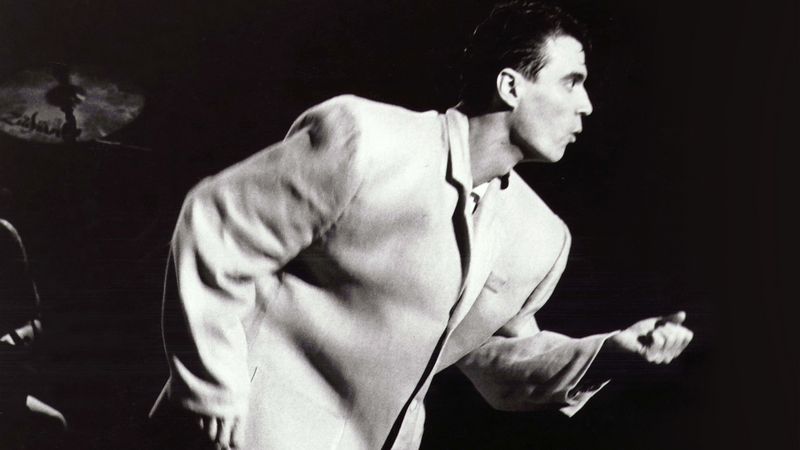THE JOURNAL

Mr David Byrne in “Stop Making Sense” (1984). Photograph by Cinecom/Shutterstock
For most people, first contact with Mr David Byrne’s supersized suit came while watching Stop Making Sense, Mr Jonathan Demme’s 1984 document of a live performance by Talking Heads from the previous year. While Byrne had worn the suit for sections of 1983’s Speaking In Tongues tour, it was its appearance on celluloid (and on the film’s posters) that cemented the image of Byrne and his plus-size formalwear in the public mind.
The suit’s entrance is exquisite – after the band minus Byrne have performed “Genius Of Love” (the standout track of their alter-ego project, Tom Tom Club), the camera picks out a distorted shadow of a man, lit from beneath, his proportions stretched and inflated. But as the camera slowly pans down and the band fire up “Girlfriend Does It Better_”_, you realise that the shadow is a faithful representation of the man and his silhouette. As Byrne moves, it becomes apparent that this isn’t simply oversized clothing – it’s more structured, something that he’s moving inside and semi-independently of, like a tortoise inside its shell.
The suit was made by costume designer Ms Gail Blacker, who in 1984 described it to The New York Times as “more of an architectural project than a clothing project”. She lined the three-button suit with needlepoint canvas to help it hold its shape and give it a degree of stiffness. The garments hung off Byrne and allowed him to dance freely, giant webbed shoulder pads and a girdle built into them so that from the side, the singer would look normal, but turning face on would reveal his sumptuous girth. “Most of the suit isn’t even touching you,” he told Entertainment Weekly in 2012. “It’s just hanging from this scaffolding.”
The grey colourway was chosen to work sympathetically with the stage lighting and allow easy coordination with the other musicians. It’s an elaborately tailored construction and when Byrne removes his jacket during the following track, “Take Me To The River”, you can see how it functions as a regular workable suit rather than a novelty stage prop.

Mr David Byrne in “Stop Making Sense” (1984). Photograph courtesy of Palm Pictures
Byrne himself is something of an unreliable narrator and has given various explanations for the outfit’s inspiration at different times. In a contemporaneous short clip, in which he is interviewed by a series of chat-show hosts (all of whom he also plays), he claims that the suit came about because “I like symmetry; geometric shapes. I wanted my head to appear smaller and the easiest way to do that was to make my body bigger. Because music is very physical, and often the body understands it before the head.”
At other times, he talked of the band being at a junction in their career and needing to enlarge their stage show, both literally and metaphorically, or of how touring Japan had exposed him to traditional Noh plays, and the image of a wide, front-facing costume with a small mask-like head above it.
Reviewing Stop Making Sense for The New Yorker, film critic Ms Pauline Kael saw echoes of Mr Joseph Beuys’ “Felt Suit”, a neo-Dada piece from 1970 with a coarse, baggy suit nailed to a wall. “He’s a handsome, freaky golem,” she wrote of Byrne. “When he dances, it isn’t as if he were moving the suit – the suit seems to move him.”
The suit represented one in an ongoing line of attempts by Byrne to subvert the codes of “straight” formalwear. In his 2012 book, How Music Works he wrote of how Talking Heads set themselves against the punk style of 1970s New York with a series of self-consciously boring images from matching polo shirts and cheap polyester suits to button down Oxford shirts. For his American Utopia show in 2018 – which returns to Broadway on 17 September – Byrne and his band mined this same impulse, appearing in matching grey suits by Opening Ceremony founder Mr Humberto Leon.
As with Byrne’s previous experiments in style, when you look closely enough, boring formalwear is never really as blank as it first appears. “When it comes to clothing, it is next to impossible to find something completely neutral,” he wrote again in How Music Works. “Every outfit carries some cultural baggage of some kind.” And the bigger the outfit, the greater the baggage.